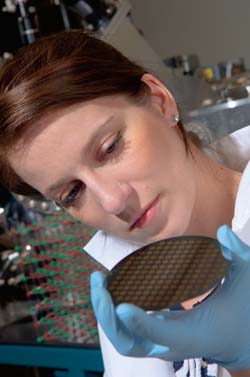 |
 |
| current issue |  | past issues |  | send a letter/news |  | address update |  | advertise |  | about us |  | alumni home |
Campus Currents
|
Germ Warfare, With Silver and Copper
By Crystal Ward Kent '78 |
Easy to print version |
The word "silver" generally conjures up images of china and white linens, not a deadly weapon against bacteria. But silver, especially combined with copper, is a highly efficient killer of dangerous germs.
 Lisa Nugent |
A UNH materials science graduate student, Dana Filoti, is trying to find out if silver and copper can be incorporated efficiently into fabric that could be used for surgical face masks and other medical products to combat infections in hospitals.
"Bacteria are simple organisms, but they are difficult to kill," says Filoti. "Many times, they go into a dormant state, only to revive again." Her research has showed that silver and copper together are especially potent, killing 99 percent of bacteria in just two hours by destroying their metabolism. The alloy can even penetrate deadly Gram-negative bacteria, including meningitis and pneumonia, which have especially strong cell walls and are often resistant to antibiotics.
Working with Louis Tisa and Tom Laue, professors in the molecular, cellular and biomedical sciences department, Filoti, who is originally from Romania and has a bachelor's degree in physics, developed procedures for synthesizing the silver and copper into thin films. She also looked at how much alloy is needed to be effective against certain types of bacteria, and if it can withstand the heat of the commercial production process.
The research is funded by Foss Manufacturing along with grants from NSF and the N.H. Innovation Research Council. Foss, a Hampton, N.H.-based manufacturer of nonwoven fabrics, is seeking methods for integrating silver and copper into material. In Foss's process, silver and copper are added to small ceramic particles, barely visible to the naked eye, and then added to polymer fibers. The ceramic protects the silver and copper during production, yet leaves the metals available when exposed to bacteria.
"If you look at the ceramic particle, it looks like a piece of Swiss cheese," explains Filoti. "And in every little hole is an ion of silver and copper."
James Harper, Filoti's advisor, explains that by optimizing the production issues, a wide range of products is possible. "The treated fabrics, known as Fossshield, are being tested for use in face masks," he notes. "These would protect people in hospitals, emergency workers going into contaminated areas, or those working on heating and ventilation systems where disease might be present. Another application is a fabric that could be used in surgical areas, for example. There are many options."
Currently, the products are being reviewed for FDA approval. Meanwhile, Filoti and the team are continuing to work on other applications. She notes, "Finding ways to use these elements could save a lot of lives."
blog comments powered by Disqus
